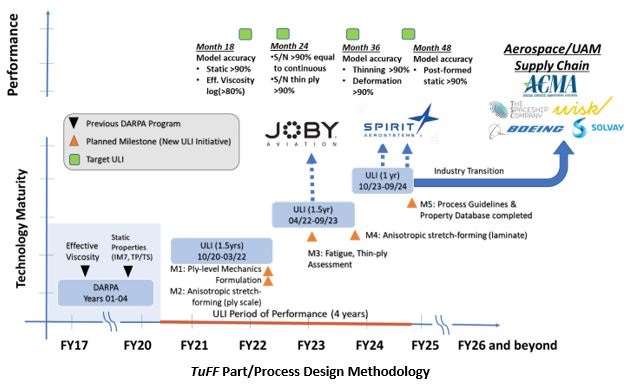NASA University Leadership Initiative (ULI) – Composite manufacturing technologies for aerospace performance at automotive production rates
Urban Air Mobility (UAM), a safe and efficient air transportation system for on-demand mobility (ODM) from small package delivery to air taxis, has arrived as the next frontier in air transportation. Market studies have established economic factors with NASA setting forth a Grand Challenge in the 2022 timeframe.

Project description
With higher production volumes and smaller size than commercial aircraft, studies have identified need for next generation composite materials and manufacturing methods to meet ODM goals of affordability, safety, and lifecycle emissions. A new paradigm shift is proposed to innovate highly aligned short fiber composites that can be stamped like sheet metal at high rate while retaining aerospace properties and tailorability in lightweight composite structures.
The University of Delaware (UD-CCM) has developed a highly aligned short fiber-based composite feedstock (>57% volume fraction) that enables automotive-like production processes at high rate (i.e. 1-minute cycle times) with properties equivalent to aerospace-grade continuous fiber composites. Single step metal-like forming of tailored blanks into complex geometries has been demonstrated. An automated pilot facility to convert fibers to parts at rate will be leveraged to create new prepreg and tailored blanks formats for model validation, database generation and forming demonstrations.
The Technical Challenge is to develop a science-based part/process design methodology for TuFF composites meeting aerospace performance at automotive manufacturing rates, as well as demonstrate at rate manufacturing capability of TuFF complex geometry parts. A combined experimental and modeling approach is leading to TuFF composite part design and manufacturing guidelines for industry transition. Modeling aspects will focus on visualizing and understanding fiber-scale mechanisms of alignment during processing, mechanical loading and rate dependent forming of highly aligned short fiber layers, development of experimentally validated constitutive models, process, and part design.
Anticipated benefits
Manufacturing research, technology transition and education of students and workforce represent the major goals of their effort. A NASA Roadmap in manufacturing and integrated structures identified UAM technology requirements over a 15-year timeframe with operational prototypes by 2026, and technology scaling by 2031. The goal of the ULI is to address technology barriers in manufacturing of complex geometry composite parts for UAM and commercial air platforms, meeting aerospace performance at automotive-like production rates, and to transition technology to their industrial partners and the US industrial base.
Their highly aligned short fiber material provides a paradigm shift away from expensive and specialized aerospace technology using continuous fiber composites to a new high-performance short fiber composite that can be designed like metals, stamp-formed like metals and reused/recycled like metals.
Student/workforce education represents a core tenet of the project and will provide opportunities for undergraduate interns, graduate research in composites manufacturing and collaborative training/education opportunities with their HBCU and industry partners. Their team also includes OEM/Tier 1 partners, material suppliers and composites industry supply chain. Annual Open Manufacturing Demonstration events are planned with feature-based, non-proprietary geometries to engage the composites eco-system in the US.













